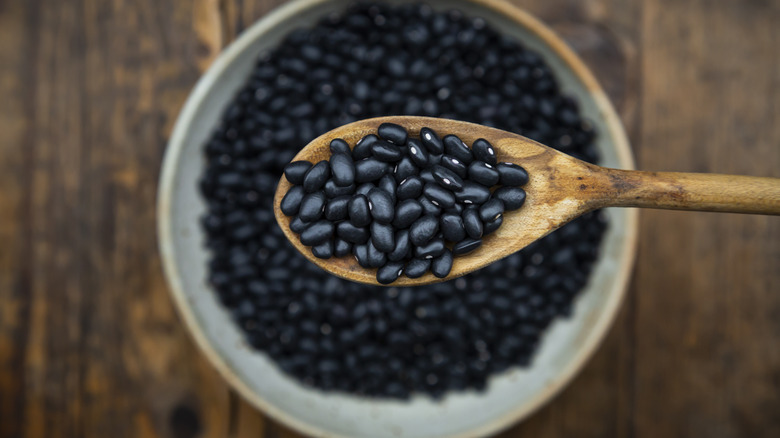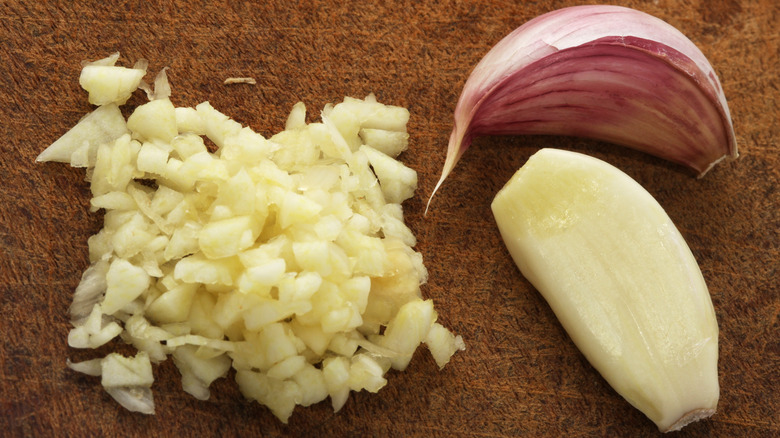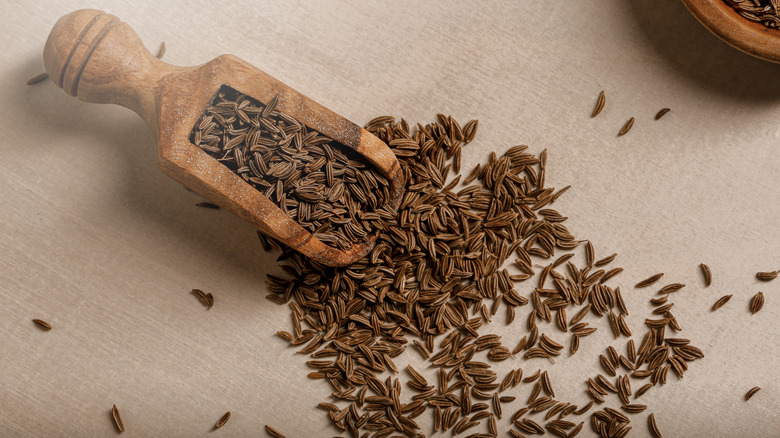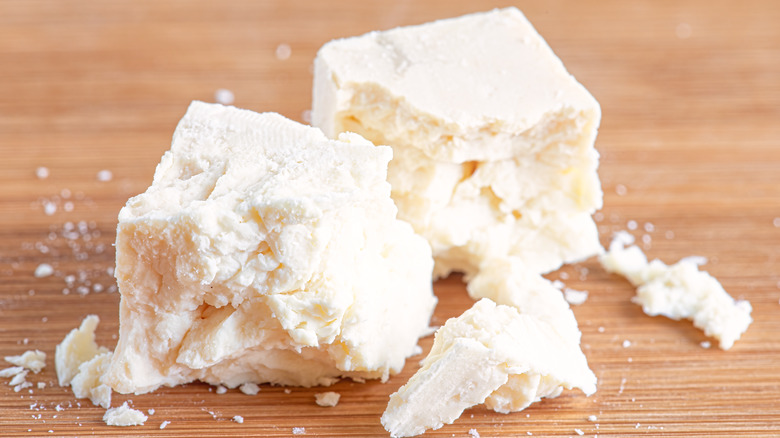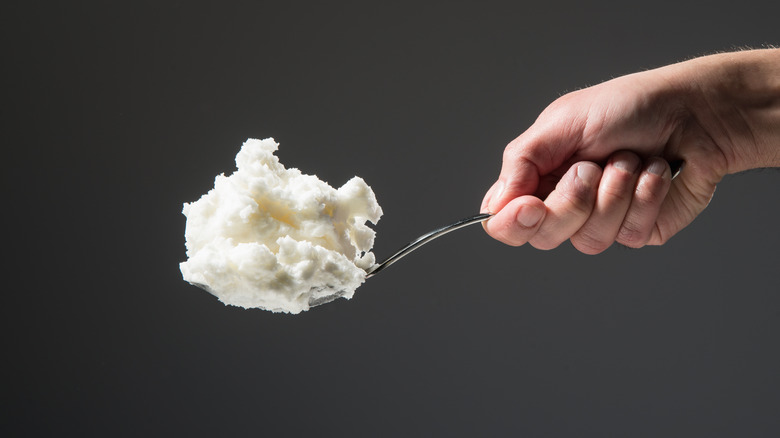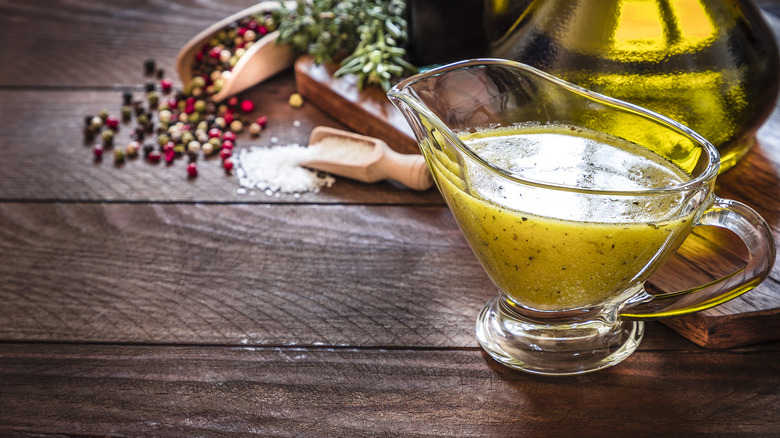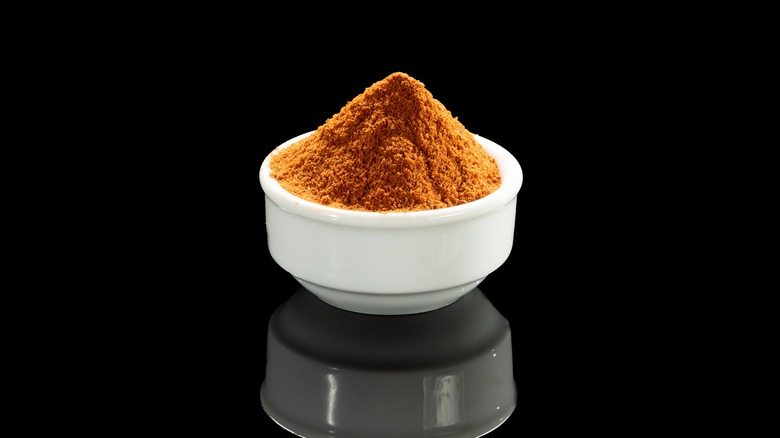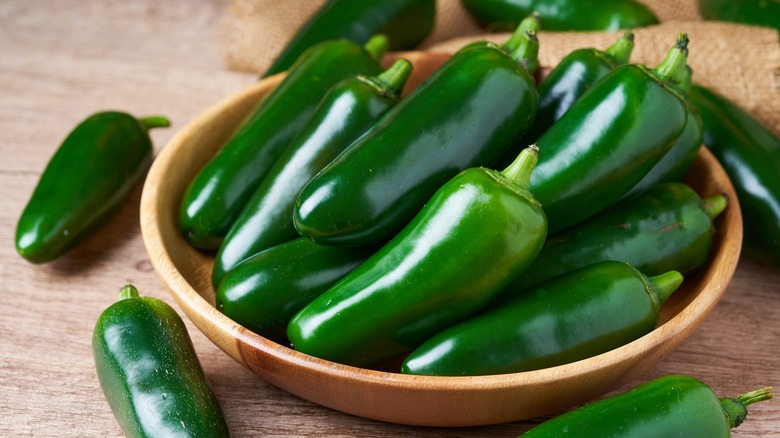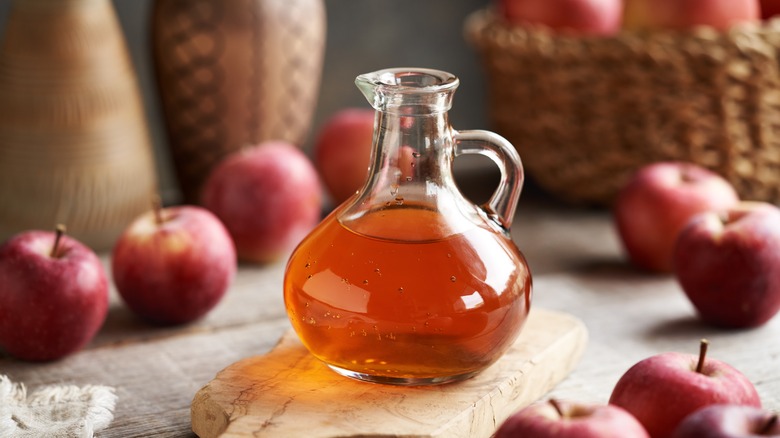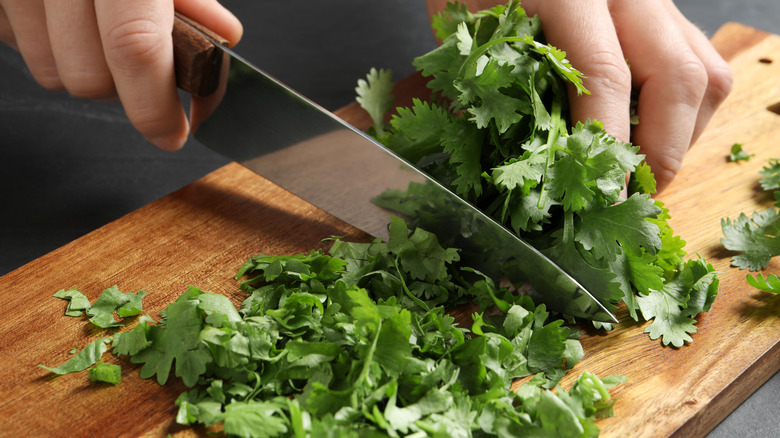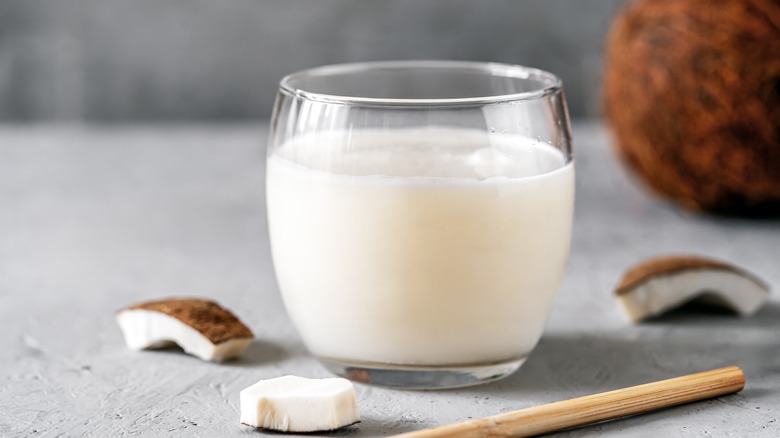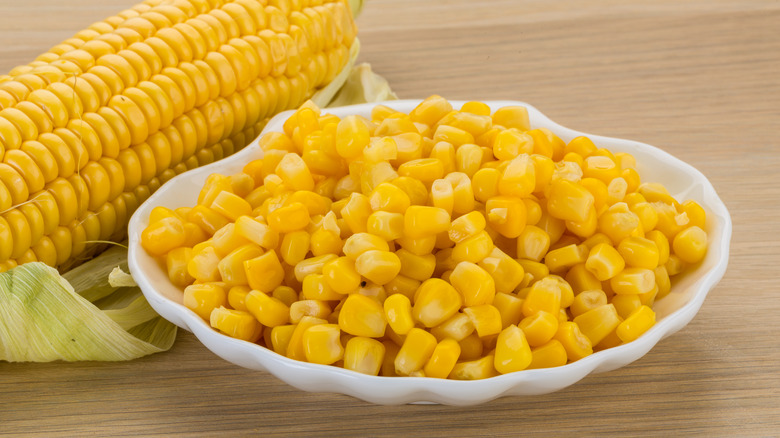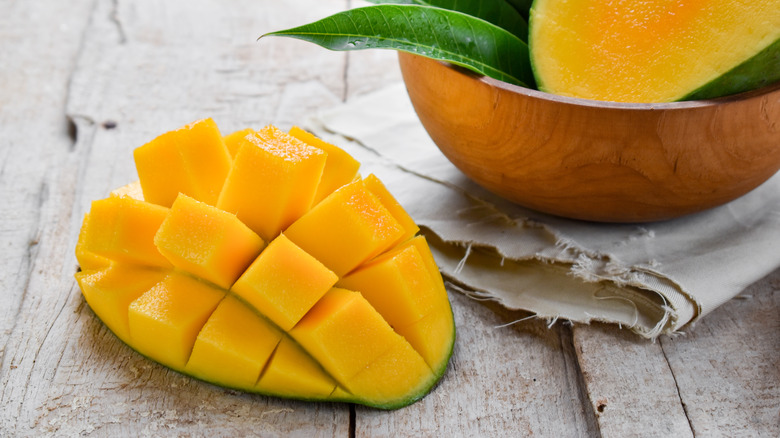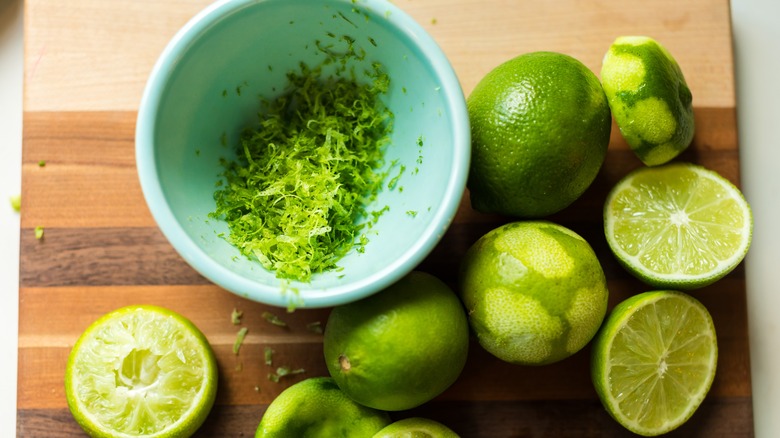14 Ingredients That Will Seriously Upgrade Canned Black Beans
Canned black beans are one of those staples that everyone likely has in their pantry. These small nuggets of nutrients are packed with fiber, protein, and carbs to keep you powered through your day. If that isn't enough to convince you to buy them, black beans (which differ from pinto beans due to their deep color and slightly more dense nutritional profile) are also versatile and easy to use. These beans can be made into classic dishes like frijoles refritos or Cuban rice and beans, or you can pair them more simply and seamlessly with a number of ingredients that highlight their naturally nutty notes and help to fill out their flavor, bringing additional touches of savoriness, sourness, and spiciness into the fray.
The good news, too, is that some of the best upgrades for black beans are likely sitting right next to them in your cupboard. Widely owned herbs and spices like cumin and cilantro are a natural fit with black beans, contrasting their gentler taste with some much-needed zip. Sweeter ingredients like mango or corn can deliver a sugary note that highlights the beans' savory notes. Plus, there are some slightly unexpected ingredients out there that can also bring these beans to life.
1. Garlic
Garlic is a fundamental flavor in countless world cuisines, and it's pretty well-known to go with basically anything. So there's little surprise that it can brighten up your black beans, either on its own or when used with other flavors. Garlic brings a serious intensity to black beans along with a savory streak that underpins their nutty flavor. It also gives your beans a moreish, perfumed aroma, which makes them all the more tempting to eat.
One of the best things about using garlic, too, is how much its flavor can change to your needs. If you cook your garlic only briefly (or use it raw), you'll give your beans a bright, sharp, somewhat spicy taste. If you cook your garlic longer to caramelize it and unlock its sweet notes, you can provide the black beans with a mellow, more developed taste. You don't have to use fresh garlic, either. Garlic granules can also give black beans a pop of garlicky flavor. As for what to add in with the garlic, the world's your oyster. It pairs well with virtually any other ingredient that you want and is a natural fit with cumin, oregano, and chicken stock. Alternatively, you can combine garlic and black beans for a simple, yet effective side dish.
2. Cumin
Cumin and black beans are kind of a match made in heaven. If you're unfamiliar with how to season black beans, this should be one of the first spices you reach for, thanks to its ability to provide a base note upon which other flavors can sit. Cumin has an inherent nuttiness that complements the nutty notes of black beans, but the spice comes at it from a different angle and gives your beans a much rounder flavor. Cumin also has a warmth to it and an aromatic quality that heightens the eating experience.
Remember that cumin seeds and ground cumin will give your beans slightly different flavors. Cumin seeds have a bolder taste than the ground version and should be sautéed in oil before you mix them with beans to unlock their flavor and aroma more capably. Crucially, it's incredibly easy to overdo it when it comes to cumin, and this is a huge mistake. Cumin can go from subtle to soapy very quickly, and if you're not careful, it will dominate any other ingredient or flavor in your dish.
3. Feta
Feta and black beans may not be a traditional pairing, but that doesn't mean the two are not delicious together — or that they lack precedent. Feta cheese has a similar consistency and flavor to young cotija cheese, a traditional finishing cheese used in Mexican dishes like tacos, burritos, and tostadas. Both cheeses can give your beans a smack of saltiness and a firm creaminess that, when warmed up, softens and lightly coats the beans. Goat's milk feta also has a noticeable funkiness that can give your beans way more depth, and some sheep's milk fetas can also have a pretty pronounced flavor, adding briny notes to these little legumes.
Using feta cheese with black beans couldn't be simpler: You just crumble it over the top, and you're good to go. You can pair the cheese with most black bean dishes — it's just as good as a soup topper as it is over a plain bowl of black beans served on the side. When crumbled over black beans and rice, it helps to bring brightness to what can sometimes be a pretty heavy dish. You don't even have to get a special type of feta, either. Just use the one your local store has.
4. Lard
A little lard can go a long way — especially when you're using it with black beans. Lard is an essential ingredient in Cuban black beans, also known as frijoles negros, where it serves as the base fat in the dish. Lard gives a richness that other fats just can't match that is essential for black beans. While vegetable-based oils can give your beans smoothness and extra body, they may lack that luxuriousness that lard delivers, coating every bean in a silky-smooth slick of fat that makes them ultra-delicious. This isn't an ingredient that vegetarians or dietitians will love, but if you eat meat, your taste buds will thank you.
Using lard in frijoles negros, or any other dish containing black beans, isn't complicated. You just incorporate it as the base fat in your dish, sautéeing your onions, vegetables, garlic, and other aromatics in it before adding the beans. We'd always recommend jazzing up your lard with additional ingredients rather than using only black beans and fat. That runs the risk of being pretty boring and tasteless. However, even if you only add a few choice ingredients like garlic and onion salt, the lard will work to brighten and intensify each flavor.
5. Italian vinaigrette
Canned black beans are often cooked with other ingredients to get maximum impact. While that's all well and good, we're also huge advocates of marinating canned black beans for extra flavor. By simply combining black beans with a marinade and letting them sit for at least 30 minutes, the beans soak up loads of additional flavor notes, becoming more intense (and way more interesting) with no extra work.
Our favorite cheat's way of doing this with minimal effort is by using an Italian vinaigrette. Vinaigrettes are easy to whip up and deliver a huge amount of punch with just a few ingredients. Just combine oil, vinegar (or some other kind of acid, like lemon juice), Dijon mustard, salt, pepper, and any other aromatics or flavors you want in there. Pop your beans in, put them in the fridge, and give them some time to absorb all the flavors. Then, you can scatter them over a salad or serve them as a side at your next barbecue. If you're feeling especially lazy, you can even do this with bottled vinaigrette. Just don't make the mistake of serving them too quickly — you'll want to let the marinade flavor permeate your beans.
6. Taco seasoning
While we'd all love to have the time to make perfectly balanced spice blends at home, most of us barely have the hours in the day to finish all our work tasks and still relax. Luckily, if you're looking for something to spice up your canned beans, taco seasoning can be your best friend. Taco seasoning usually covers all the bases you need by including the major spices used in Mexican and Tex-Mex cuisine, like chili powder, paprika, onion and garlic powders, and herbs like oregano. Importantly, taco seasoning blends can differ from brand to brand, so it's always good to check which spices make up your chosen one.
Taco seasoning also usually includes salt, eliminating the need to add extra to your beans. Plus, the seasoning mix removes the requirement for you to have to judge the balance of your spices, as all the hard work's done for you. If you're particularly pressed for time, you can simply sprinkle taco seasoning onto raw beans and chow down, but we would always recommend cooking the taco seasoning first. Cooking it in oil allows all of the flavors to unlock, producing even more depth for your dish.
7. Jalapeños
If you're in the market to spice up your black beans, you shouldn't look any further than jalapeños. Jalapeños are the perfect vessel to add heat and vegetal brightness to your bean-based dish, with both fresh and jarred jalapeños delivering the intensity you need. If you want to keep things quick, mixing sliced jarred jalapeños with black beans is a store-cupboard-friendly way of making a spicy side dish. The peppers will add heat, while the brine they're soaked in will season the beans, removing any need for salt or an acidic element.
If you want to make something a little more fancy, take a fresh jalapeño and sauté it with onion, garlic, and a little cumin and then mix in your black beans to create a side dish that's incredibly aromatic and flavorful. When working with the fresh variety of the pepper, it can be a little tricky to tell how much heat you're getting yourself into. That's why you should always check for stretch marks. If your jalapeño has white lines or specks on it, it's a good sign that it's stretched as it has grown, with this maturation process developing more heat in the pepper itself. If the pepper is smooth, it's probably younger and therefore less spicy.
8. Apple cider vinegar
Black beans can sometimes get a little heavy and pulpy-tasting, and it's important not to try and solve this by just adding savory elements. While these can work to bring out the flavor of your beans, you risk unbalancing them — and if you want canned black beans to taste truly rounded, you need acidity. Apple cider vinegar is the perfect partner here. Apple cider vinegar (or ACV) has a sweet note that counteracts its sourness and a complex scent that adds way more than simple white vinegar. It can also have a gentle funkiness that makes its flavor profile slightly more complicated and well-rounded.
It's best not to use apple cider vinegar on its own, as the combination of beans and vinegar will make for a pretty weird dish. Instead, you should aim to use ACV as a balancing component with other ingredients. Add a dash of it to black beans sautéed with onions, garlic, and jalapeños, and simmered in chicken broth. Make sure to add a pinch of sugar to stop the ACV from taking over; you want it to work as a flavor enhancer, not as the dominant flavor. It can also be great in black bean salads as part of a dressing or vinaigrette, where it can add loads of extra taste notes.
9. Honey
Honey and black beans are an unexpected but delicious combo. Honey gives black beans a fruity, floral quality that other sweeteners don't quite match while simultaneously providing a contrast and lightness to the beans' nutty flavor and murky color. You can use honey in virtually any capacity that you'd use sugar in, and it'll have the same brightening effect. It'll also add a touch more thickness than white or brown sugar would.
You shouldn't be shy about adding sweetness to black beans: Given that some chefs, like Giada di Laurentiis, add canned black beans into their brownies, the legumes are surprisingly adept at taking on sugary flavors. Serving a bowl of black beans mixed simply with honey, however, probably won't win you any new fans. We way prefer rustling up a bowl of honey-rum black beans, an ingenious creation from Bobby Flay that combines honey and dark rum with other ingredients to deliver something smoky, sweet, savory, and unbelievably tasty.
10. Cilantro
If you can name a better herb than cilantro to pair with black beans, we'd love to hear about it. Until then, we're sticking with this one. Cilantro is the quintessential herb in Mexican cuisine, where it both complements and contrasts the bold flavors often present. Its fresh, zesty herbal notes, which have a hint of pepperiness, pair well with spices and bold-tasting meats. Cilantro is just as good when it comes to black beans, where it can provide an herbal counterpoint to the legumes' denseness.
You can use cilantro in virtually any dish that has black beans in it. Our favorite use has to be in black bean tacos, where cilantro helps to add freshness to the somewhat dense combo of beans, bread, and cheese. You can also scatter cilantro on top of a black bean soup or casserole, use it to give frijoles refritos a bit more bounce, or chop it up and scatter it into a black bean salad. No matter where you use it, cilantro gives an inimitable flavor that you'll miss when it's gone.
11. Coconut milk
People commonly reach for stock or broth when making a liquid-based black bean dish. However, we'd implore you to use coconut milk instead. Coconut milk gives all the thickness of cream without any of the dairy and provides a fatty richness that smooths out the black beans. Coconut milk's slightly nutty flavor profile pairs perfectly with the gentle nuttiness of black beans, with its adaptability meaning that it can take on both savory and sweet flavors well.
That adaptability is perfect for one of our favorite dishes that combines coconut milk and canned black beans along with honey, onions, garlic, and spices like paprika and black pepper. As the black beans cook, they'll absorb the coconut milk, making each individual bean plump and full of flavor. You then spoon the mixture over a bed of white rice and hoover it up with a spoon. Try it out, and thank us later.
12. Corn
It probably doesn't take much convincing for you to see that corn and black beans are a match made in heaven, but hey, we're gonna do it anyway. Both corn and black beans are part of the family when it comes to Mexican cuisine. They're so commonplace that it's easy to forget how good they are when paired together — but when they are, with the sweetness from the corn brightening up the black beans and adding sugary notes and juicy pops of moisture, they positively sing.
The best thing about combining corn and black beans is you really don't need many other ingredients to go with them. If you want, you can make an easy black bean corn salad by combining canned corn, canned black beans, red onion, cilantro, and feta cheese with an oil and red-wine vinegar dressing. Serve alongside tacos, with rice, or next to your favorite cut of grilled meat.
13. Mango
When you want to sweeten up your black beans but don't necessarily want to use sugar or some other sweetener, mango is your best friend. Cubed mango, in all its fruity, automatic sweetness, goes surprisingly well with canned black beans. Not only does it add some all-important vibrant color to your bowl of beans, but it also delivers a crucial tanginess that offsets the mango's sweetness and somehow rounds out the flavors of the legumes.
In our opinion, mango goes best with black beans when used as part of a salad. Try this black bean avocado salad with mango and quinoa. While your quinoa is cooking, mix together black beans with mango, scallions, cilantro, and a bit of salt. Add the cooked quinoa. Then in a separate bowl, make the dressing with lime juice, olive oil, shallots, and avocado. Combine the two sets of ingredients, then let everything cool in the fridge so the flavors meld. This salad is perfect for preparing ahead and taking to a barbecue or potluck, as it travels well and can be dressed way in advance.
14. Lime zest
Lime is one of the primary flavors in Mexican cuisine, and it's no secret that it goes well with black beans. How you use your lime, however, can make a great deal of difference -– not enough people use the zest as well as the juice. Lime juice gives any dish acidity and brightness. But if you want that perfumed, citrus flavor and aroma in full force, you have to use the zest. Zesting your lime will release the fruit's aromatic oils, which then infuse with your beans, giving them way more punch and stopping them from becoming too dense or pulpy.
You can use lime zest with black beans any time you're using lime juice to intensify the citrus flavors. If you want the flavor to really stand out, it's usually better to use it raw, instead of cooking it, which can somewhat kill the fresh flavor. Try adding zest to a lime dressing that you can marinate the black beans in. You can also add corn, bell pepper, cherry tomatoes, and onion to the marinated beans. As all of these ingredients sit, the flavors will meld and mellow, with the zest perfuming every element beautifully.
